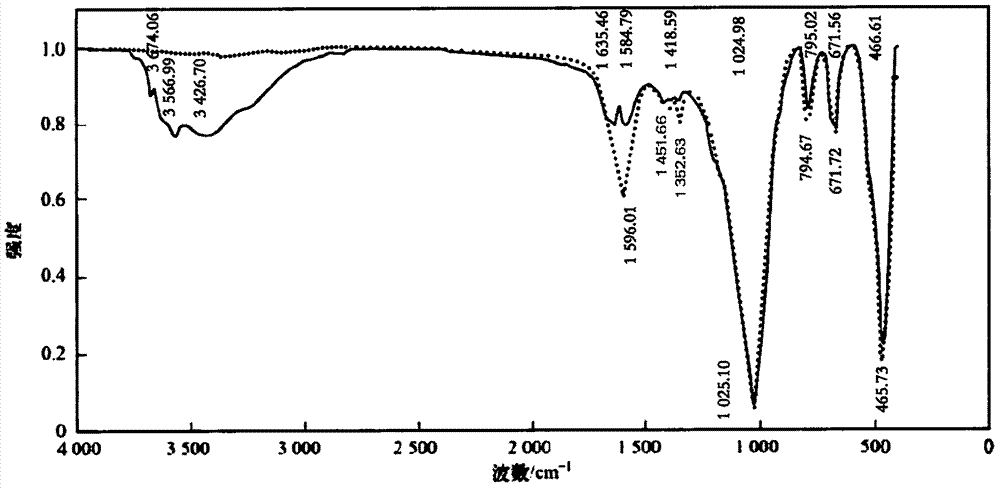Stabilized lead-polluted soil restoration method
A technology of lead-contaminated soil and a remediation method is applied in the field of heavy metal-contaminated soil remediation, which can solve the problems of small current action distance and high treatment cost, and achieve the effects of good adsorption and improvement of stabilization effect.
- Summary
- Abstract
- Description
- Claims
- Application Information
AI Technical Summary
Problems solved by technology
Method used
Image
Examples
Embodiment 1
[0053] The preparation of embodiment 1 modified sepiolite
[0054] Put the sepiolite in the heating furnace and raise the temperature to 130°C. During the heating process, the temperature rises evenly, increasing 1°C to 2°C per minute, and then keeps at this temperature for 15 hours to eliminate the moisture on the surface of the sepiolite and in the pores. The sepiolite that eliminates moisture is put into the solution that pyridine 2,6-dicarboxylic acid is housed rapidly, and described pyridine 2,6-dicarboxylic acid is dissolved in water, and the concentration of solution is 30g / L, stirs and soaks for 5 days, obtains Picolinic acid-modified sepiolite.
[0055] The modified sepiolite is detected by infrared spectroscopy, and the infrared absorption spectrum is measured by a Magna560ESP Fourier transform infrared spectrometer, KBr is pressed into tablets, and the analysis range is 400-4000cm -1 .
[0056] Such as figure 1 As shown, compared with sepiolite, picolinic acid mo...
Embodiment 2
[0060] The soil that this embodiment is aimed at is a certain lead-contaminated soil, and the lead concentration in the soil is 7420mg / kg, and according to " solid waste leaching toxicity leaching method sulfuric acid nitric acid method " (HJ / T 299-2007) leaching concentration is 286mg / L, test The area is 5m×5m.
[0061] The main steps to remediate the lead-contaminated soil are as follows:
[0062] (1) Preparation of composite stabilizer: sodium tripolyphosphate and the modified sepiolite prepared in Example 1 are fully mixed with a mass ratio of 3:7 to prepare a composite stabilizer;
[0063] (2) Dosing of composite stabilizer: apply 4% of the composite stabilizer to the polluted soil into the lead-contaminated soil through crushing and screening, and mix the medicament and soil evenly;
[0064] (3) Preparation of analytical solution: MgCl 2 ·6H 2 O is dissolved in water and formulated as a 0.3% magnesium chloride solution;
[0065] (4) Dosing of desorbent solution: Spra...
Embodiment 3
[0069] The soil that this embodiment is aimed at is a certain lead-contaminated soil, and the lead concentration in the soil is 3750mg / kg, and according to " solid waste leaching toxicity leaching method sulfuric acid nitric acid method " (HJ / T 299-2007) leaching concentration is 134mg / L, test The area is 5m×5m.
[0070] The main steps to remediate the lead-contaminated soil are as follows:
[0071] (1) Preparation of composite stabilizer: sodium tripolyphosphate and the modified sepiolite prepared in Example 1 are fully mixed with a mass ratio of 1:9 to prepare a composite stabilizer;
[0072] (2) Dosing of composite stabilizer: Apply 7% of the composite stabilizer to the polluted soil into the lead-contaminated soil through crushing and screening, and mix the medicament and soil evenly;
[0073] (3) Preparation of analytical solution: CaCl 2 2H 2 O is dissolved in water and formulated as a 0.1% calcium chloride solution;
[0074] (4) Dosing of desorbent solution: Spray t...
PUM
| Property | Measurement | Unit |
|---|---|---|
| Concentration | aaaaa | aaaaa |
| Concentration | aaaaa | aaaaa |
| Concentration | aaaaa | aaaaa |
Abstract
Description
Claims
Application Information
 Login to View More
Login to View More - R&D
- Intellectual Property
- Life Sciences
- Materials
- Tech Scout
- Unparalleled Data Quality
- Higher Quality Content
- 60% Fewer Hallucinations
Browse by: Latest US Patents, China's latest patents, Technical Efficacy Thesaurus, Application Domain, Technology Topic, Popular Technical Reports.
© 2025 PatSnap. All rights reserved.Legal|Privacy policy|Modern Slavery Act Transparency Statement|Sitemap|About US| Contact US: help@patsnap.com

